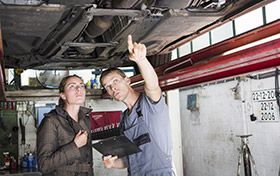Inspection Criteria For Passenger Cars and Light Duty Trucks
Safety inspections for passenger cars and light-duty trucks require that the following items be checked: suspension components, steering, braking systems, tires and wheels, lighting and electrical systems, glazing (glass), mirrors, windshield washer, defroster, wipers, fuel systems, the speedometer, the odometer, the exhaust systems, horns and warning devices, the body, and chassis. For most vehicles in the 42 county, Non-I/M region this safety inspection will also include a Visual Anti-Tampering Check. The Visual Anti-Tampering Check is an examination of the vehicle to see if the required emissions components have been tampered with or removed. For more information concerning the 42 County Visual Anti-Tampering Check, please visit the PA Code Website. For a complete list of the rejection criteria for passenger cars and light duty trucks, please visit the PA Code Web site.
Drive Cycles
If a 1996 or newer vehicle is not ready for testing because too many readiness monitors are not set, the vehicle may be put through a “drive cycle”. The drive cycle is a prescribed driving routine specified by the vehicle manufacturer. There is no generic drive cycle. Each vehicle has drive cycles specific to the make and model of the vehicle, therefore, every drive cycle will be different for every vehicle. If your vehicle is not ready for testing, check with your service provider or the vehicle manufacturer to determine the correct drive cycle for the monitor that is “not ready” for your make and model vehicle. Simply driving the vehicle may not guarantee the monitors will be set to “ready”.
“Check Engine” Light
When your vehicle’s check engine light illuminates it means that something is wrong. At the very least, you may be using more fuel than you need to. If you have your vehicle serviced when the check engine light is illuminated, you are taking the right steps towards repairing the problem while contributing to improving Pennsylvania’s air quality. Ignoring the check engine light and continuing to drive the vehicle may result in more costly repairs down the road. You may have heard that if the “check engine” light is illuminated, the way to make a vehicle ready to have the OBD test is to disconnect the battery for a few minutes, then reconnect it to make the “check engine” light go out. Nothing could be further from the truth. Whatever you do, DO NOT disconnect the battery! Disconnecting the battery will cancel the OBD systems monitors and make the vehicle “not ready” for testing. This practice will only add time and expense when you take your vehicle to be tested.
If your “check engine” light is on and your vehicle is due for inspection, it would be beneficial for you to take your vehicle in for the OBD inspection early in the cycle. If it fails the OBD inspection, this will help assure that there is sufficient time to repair the vehicle and to re-set any needed monitors prior to a reinspection.



